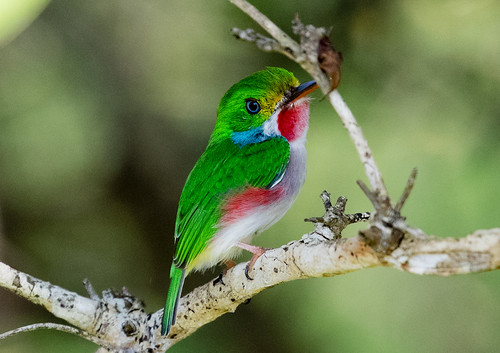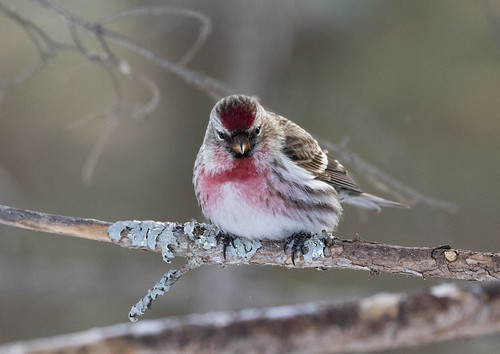A few weeks ago, I got a package in the mail from one of my friends, Mark Roser. It was trademarked “Laughing Birds,” which of course I found charming, and contained two small bags of sunflower hearts, peanuts, and tree nuts; a macramé hanger and little clay dish; a pair of cotton gloves; and Mark’s Guidebook to Interactive Bird Feeding. I instantly seized upon that phrase, “interactive bird feeding,” because that’s pretty much what I do. And the heading on the back cover read, “Travel to the depths of your own back yard and uncover what has been there all along.” Yep—this sounded like it would be right up my alley.
But I was also a little skeptical. On Facebook, when I see a photo of a wonderful bird—especially a beautiful hummingbird or tiny songbird—I try not to look at the comments, because invariably, some people will type "WANT," and they don’t mean they want to see one for their life list or to photograph it—they mean they want that beautiful thing for a pet, as if we humans could possibly actually own a wild creature any more than we could own the sun or the moon or the stars. Wild creatures belong to themselves.
 |
| A few people commented on my flickr photo of a Cuban Tody that they wished they could have one. I did NOT publish those comments. |
Fortunately, the book laid my fears to rest. Mark starts by explaining three kinds of bird feeding, which he calls primary, specialty, and interactive. Those of us with feeding stations understand primary and secondary feeders—the primary ones filled with sunflower or other seeds we buy in bulk to attract a wide variety of birds, and the specialty ones designed to appeal to specific types of birds. Nyjer attracts finches, suet attracts woodpeckers and nuthatches, and white millet attracts doves and juncos. Normally, we fill these feeders and then go inside to watch. Chickadees, redpolls, and a few other species may learn to associate us with filling the feeders, and may approach while we’re right there—some of them also start coming to our hands—but most of the birds who come to feeding stations wait until they can’t see us.
 |
| A few of my neighborhood Blue Jays approach me for peanuts, but this migratory flock is too busy bulking up to waste time forging relationships with humans. If I came near, they'd disappear. |
 |
| This one kindly posed in exchange for peanuts so I can pretend my ABA award is Blue Jay approved. |
Interactive feeders offer only small amounts of the most enticing foods—peanuts and nut meats, sunflower hearts, and expensive items like that. By limiting the amount and offering it only while we’re nearby, some birds readily learn to accept our presence. Mark explains how to offer it in the little clay dish and how to get the birds used to our presence.
Soon we can hold the dish in our hand and little birds will come right to it. The next step is to hold the seed in our hand without the dish. That’s where the cotton gloves come in—our hands and birds’ feet all bear germs and some birds have sharper claws than others. The gloves offer a bit of protection on both sides.
Near the beginning of the book there's a box about safety. He encourages people to invite children, people with disabilities, people in senior centers, and people isolated from others to learn how to do this, too, but writes:
Please be sure that you make the safety measures 100% clear. The approaches described in this book put birds in a very vulnerable position and should not be taught to anyone who does not have a sincere desire and ability to safely care for birds.
If you do not feel that the person can keep the birds safe, then please don’t hold the sharing cup or hand-feed that day. You can watch closely with the birds nearby but without contact.
I particularly like Mark Roser’s recognition that birds are their own selves. His interactive guide shows, step by step, how to get your backyard birds comfortable coming closer to you, but he also explains that some birds are reluctant to come too close, such as bluebirds and cardinals, and why we shouldn’t try to break that barrier. He writes,
As I got to know the birds, some of them by name, I began to recognize that when I stepped out of my house, I was actually stepping into theirs… As I spent time with them, I became more sensitive to what could be helpful and what could scare them away or hurt them. With each step forward and two steps back, my vantage point was being changed and my intention and hopes shifted within me.
Mark writes about the importance of only offering as much food as birds can finish fairly quickly so it doesn’t spoil. But A Guidebook to Interactive Feeding does not cover in any depth one serious issue that develops as winter melds into spring, when warm temperatures hasten the decay process of spilled seeds and seed shells. The bazillions of redpolls people have been exulting in this winter often eat on the ground, maintaining little personal distance from one another. We must keep those seeds raked and discarded to protect the birds. But redpolls move about and can pick up diseases elsewhere, too, and spread the disease in our backyards. Sadly, if we see ANY sick redpolls, House Finches, or other birds, it’s imperative to close down our feeding station until the flocks disperse. After dealing with a pandemic for two years, most of us understand why restaurants had to change a lot of protocols, so this should be reasonably understandable.
Ironically, Mark’s system of interactive bird feeding can continue full on even if we’ve had to shut down our main feeders, as long as we aren’t inviting sick birds to be eating anywhere near where we’re inviting healthy birds. Feeding birds is a Good Thing right up until it isn’t.
Most of us may not be rocket scientists or brain surgeons, but we should be able to use our human instincts to protect our backyard birds. Mark Roser’s Guide to Interactive Bird Feeding, available via laughingbirds.com, is an excellent approach to growing more aware of and more deeply enjoying our backyard birds.


